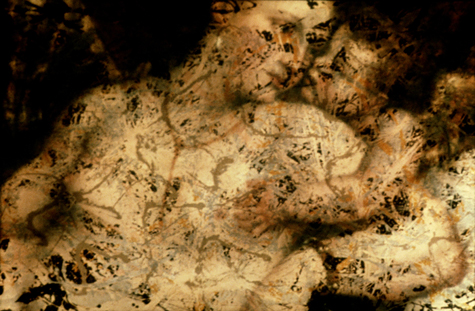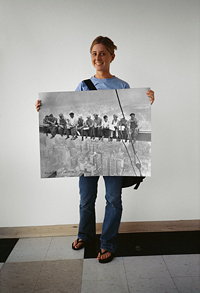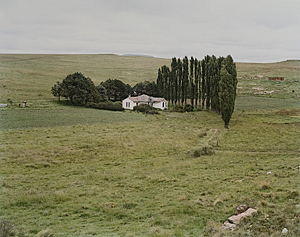
Over the past several years, the Mildred Lane Kemper Art Museum has built an exceptional collection of works by an international array of contemporary artists who both examine and expand the parameters of traditional photography.
For these artists, photography is not a single, rigidly defined discipline or practice, but a versatile medium that can be filtered through a range of artistic processes and used to address a range of aesthetic questions and concerns.

Christian Jankowski (German, b. 1968). From Poster Sale, 2005. Color photograph, 14 x 11”. Mildred Lane Kemper Art Museum, Washington University in St. Louis. University purchase, Parsons Fund and Art Acquisition Fund, 2005. High-res version available upon request.
Beginning this week, the Kemper Art Museum will showcase this collection in Focus on Photography: Recent Acquisitions. The exhibit opens with a reception at 7 p.m. Friday, May 7, and remains on view through July 26. Both the reception and exhibition are free and open to the public.
Organized by assistant curator Karen Butler, the exhibition will feature more than 100 pieces by more than 20 artists, ranging from historical figures who helped define early photographic standards to contemporary photographers working within what art historian George Baker has termed “photography’s expanded field.” Taken together, these artists offer a lens through which to address the question: What is photography today?
The earliest works on view are rooted in photography’s documentary tradition. Edward Curtis sought to record and preserve the culture of disappearing Native American tribes, yet he also was deeply influenced by aesthetic conventions — the portrait, the pastoral landscape — borrowed from traditions of painting.
This dichotomy reflects the complex nature of early 20th-century photography, which frequently negotiated between scientific instrument and artistic endeavor. Conversely, in artfully staged portraits such as Picasso, Cannes (1955), Lucien Clergue consciously attempted to supplant the painted portrait with a photographic image capturing the individual’s psychological essence.
The work of artists such as Andy Warhol and Louise Lawler would further transform our understanding of the photographic image, radically undermining its apparent promise of objective knowledge or truth.
Warhol, who lived life both through and for the camera, is represented by a large group of working Polaroids and black-and-white snapshots, the latter of which portray personal and public activities but, paradoxically, reveal very little about Warhol himself.
Lawler, meanwhile, is represented by Not Yet Titled (2004/05), a recent example from a long line of photographs that investigate the life of artworks after they leave the studio and enter the public domain.
These figures set the stage for a vast array of artists whose varied forms of critical engagement define the state of photography today. In Ecrivain public / Public letter writer, Rafaèle Decarpigny (2007), Sophie Calle uses photography to explore questions of subjectivity and identity, creating an unconventional portrait out of the response of one woman, a professional letter writer, to an upsetting e-mail that Calle received from a boyfriend.
Questions of identity also inform Christian Jankowski’s series Poster Sale (2005), which depicts 40 Washington University students posing with images they had selected to decorate their dorm rooms, thus allowing viewers to glimpse the ways popular culture contributes to the construction of individuality.

David Goldblatt (South African, b. 1930). Abandoned farmhouse near Molteno, Eastern Cape, 25 February 2006. Digital print on 100 percent rag cotton paper in pigment inks, 36 x 44″. Mildred Lane Kemper Art Museum, Washington University in St. Louis. University purchase, Yalem Fund, 2006. High-res version available upon request.
In Untitled (Pollock/Titian) #4 (1984/2005), Andrea Fraser deploys photography as a form of institutional critique by juxtaposing and then rephotographing slides of well-known paintings by two renowned male artists.
Wolfgang Tillmans, in Wald (Briol II) (2008), addresses the issue of photographic representation head-on by photocopying his own photograph, of a man walking through a forest, rendering it dark, flat and blurry. Tillmans then scanned, enlarged and printed the photocopy again, this time as a singular image, thus placing it somewhere between a photograph and a unique artwork.
Rounding out the exhibition will be recently acquired works by Howard French, David Goldblatt, Doug Hall, Ulrike Kuschel, Sharon Lockhart, Alen MacWeeney, Abelardo Morell, Simon Nieweg, Georges Rousse, Georgina Starr and John Stezaker.
Mildred Lane Kemper Art Museum
The Mildred Lane Kemper Art Museum, part of the Sam Fox School of Design & Visual Arts, is committed to furthering critical thinking and visual literacy through a vital program of exhibitions, publications and accompanying events. The museum dates back to 1881, making it the oldest art museum west of the Mississippi River. Today, it boasts one of the finest university collections in the United States.
The museum is located on Washington University’s Danforth Campus, near the intersection of Skinker and Forsyth boulevards. Regular hours are 11 a.m. to 6 p.m. Mondays, Wednesdays and Thursdays; 11 a.m. to 8 p.m. Fridays; and 11 a.m. to 6 p.m. Saturdays and Sundays. The museum is closed Tuesdays. For more information, call (314) 935-4523 or visit kemperartmuseum.wustl.edu.
| WHO: Mildred Lane Kemper Art Museum WHAT: Exhibition, Focus on Photography: Recent Acquisitions WHEN: May 7 to July 26. Opening reception 7 to 9 p.m. Friday, May 7 WHERE: Mildred Lane Kemper Art Museum, Washington University in St. Louis, near the intersection of Forsyth and Skinker boulevards HOURS: 11 a.m. to 6 p.m. Monday, Wednesday and Thursdays; 11 a.m. to 8 p.m. Fridays; 11 a.m. to 6 p.m. Saturdays and Sundays. Closed Tuesdays. COST: Free and open to the public INFORMATION: (314) 935-4523 or kemperartmuseum.wustl.edu |